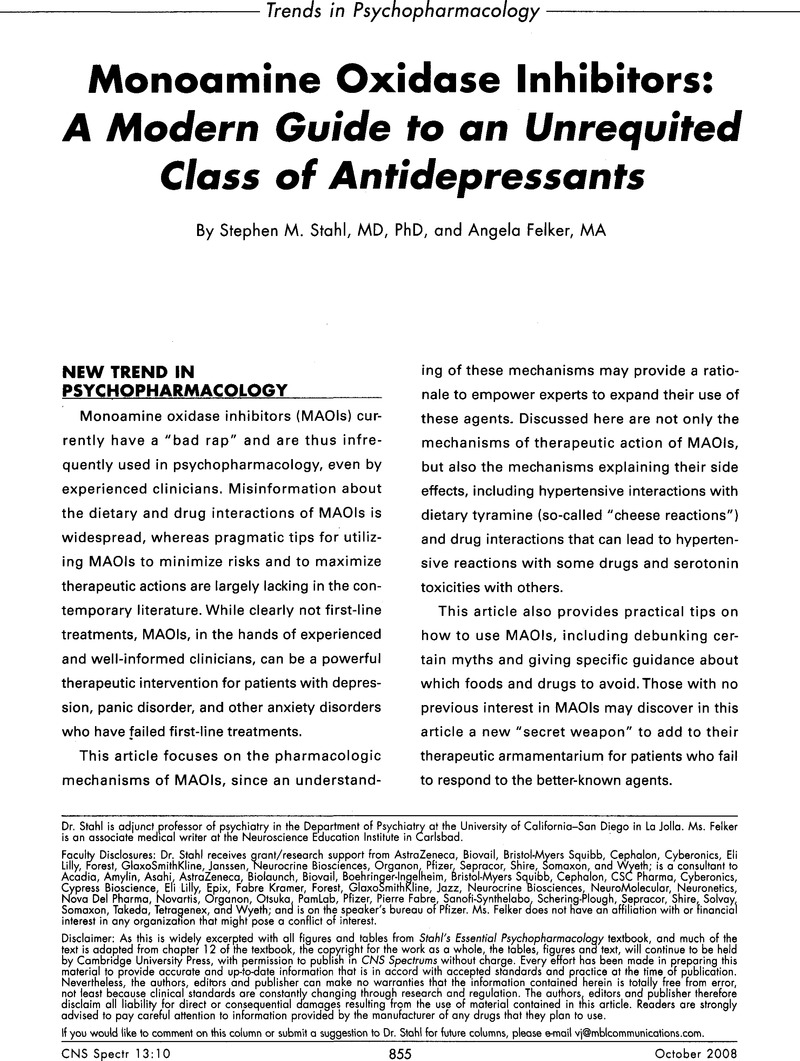Crossref Citations
This article has been cited by the following publications. This list is generated based on data provided by Crossref.
Nicolson, Stephen E.
Caplan, Jason P.
Williams, Deidre E.
and
Stern, Theodore A.
2009.
Comorbid Pain, Depression, and Anxiety.
Harvard Review of Psychiatry,
Vol. 17,
Issue. 6,
p.
407.
Franklin, Tamara B.
Russig, Holger
Weiss, Isabelle C.
Gräff, Johannes
Linder, Natacha
Michalon, Aubin
Vizi, Sandor
and
Mansuy, Isabelle M.
2010.
Epigenetic Transmission of the Impact of Early Stress Across Generations.
Biological Psychiatry,
Vol. 68,
Issue. 5,
p.
408.
Fišar, Zdeněk
2010.
Inhibition of monoamine oxidase activity by cannabinoids.
Naunyn-Schmiedeberg's Archives of Pharmacology,
Vol. 381,
Issue. 6,
p.
563.
Bowden, Charles L.
2010.
Behavioral Neurobiology of Bipolar Disorder and its Treatment.
Vol. 5,
Issue. ,
p.
263.
Rojas-Fernandez, Carlos H.
Miller, Lisa J.
and
Sadowski, Cheryl A.
2010.
Considerations in the Treatment of Geriatric Depression.
Research in Gerontological Nursing,
Vol. 3,
Issue. 3,
p.
176.
Fišar, Zdeněk
Hroudová, Jana
Korábečný, Jan
Musílek, Kamil
and
Kuča, Kamil
2011.
In vitro effects of acetylcholinesterase reactivators on monoamine oxidase activity.
Toxicology Letters,
Vol. 201,
Issue. 2,
p.
176.
Perez-Lloret, Santiago
and
Rascol, Olivier
2011.
Safety of rasagiline for the treatment of Parkinson's disease.
Expert Opinion on Drug Safety,
Vol. 10,
Issue. 4,
p.
633.
Macedo, Ana
Leiria, Eva
and
Filipe, Augusto
2011.
Pirlindole in the Treatment of Depression.
Clinical Drug Investigation,
Vol. 31,
Issue. 1,
p.
61.
Stevens, Jonathan R.
Fava, Maurizio
Rosenbaum, Jerrold F.
and
Alpert, Jonathan E.
2011.
Massachusetts General Hospital Handbook of General Hospital Psychiatry.
p.
441.
Wichitnithad, Wisut
O’Callaghan, James P.
Miller, Diane B.
Train, Brian C.
and
Callery, Patrick S.
2011.
Time-dependent slowly-reversible inhibition of monoamine oxidase A by N-substituted 1,2,3,6-tetrahydropyridines.
Bioorganic & Medicinal Chemistry,
Vol. 19,
Issue. 24,
p.
7482.
Gillman, Peter Kenneth
2011.
Advances Pertaining to the Pharmacology and Interactions of Irreversible Nonselective Monoamine Oxidase Inhibitors.
Journal of Clinical Psychopharmacology,
Vol. 31,
Issue. 1,
p.
66.
Dodd, Seetal
Malhi, Gin S.
Tiller, John
Schweitzer, Isaac
Hickie, Ian
Khoo, Jon Paul
Bassett, Darryl L.
Lyndon, Bill
Mitchell, Philip B.
Parker, Gordon
Fitzgerald, Paul B.
Udina, Marc
Singh, Ajeet
Moylan, Steven
Giorlando, Francesco
Doughty, Carolyn
Davey, Christopher G.
Theodoros, Michael
and
Berk, Michael
2011.
A Consensus Statement for Safety Monitoring Guidelines of Treatments for Major Depressive Disorder.
Australian & New Zealand Journal of Psychiatry,
Vol. 45,
Issue. 9,
p.
712.
Richards, Grayson
Messer, Juerg
Waldvogel, Henry J.
Gibbons, Hannah M.
Dragunow, Mike
Faull, Richard L.M.
and
Saura, Josep
2011.
Up-regulation of the isoenzymes MAO-A and MAO-B in the human basal ganglia and pons in Huntington's disease revealed by quantitative enzyme radioautography.
Brain Research,
Vol. 1370,
Issue. ,
p.
204.
Desmidt, T.
and
Camus, V.
2011.
Psychotropes et sujet âgé.
EMC - Psychiatrie,
Vol. 8,
Issue. 2,
p.
1.
Watts, Stephanie W.
and
Davis, Robert Patrick
2011.
5-Hydroxtryptamine Receptors in Systemic Hypertension: An Arterial Focus.
Cardiovascular Therapeutics,
Vol. 29,
Issue. 1,
p.
54.
Herrera-Ruiz, Maribel
González-Carranza, Adolfo
Zamilpa, Alejandro
Jiménez-Ferrer, Enrique
Huerta-Reyes, Maira
and
Navarro-García, Víctor M.
2011.
The standardized extract of Loeselia mexicana possesses anxiolytic activity through the γ-amino butyric acid mechanism.
Journal of Ethnopharmacology,
Vol. 138,
Issue. 2,
p.
261.
O’Brien, Virginia
2011.
The Monoamine Oxidase Inhibitors: Relics Reconsidered.
Psychiatric Annals,
Vol. 41,
Issue. 3,
p.
176.
Lum, Christopher T.
and
Stahl, Stephen M.
2012.
Opportunities for reversible inhibitors of monoamine oxidase-A (RIMAs) in the treatment of depression.
CNS Spectrums,
Vol. 17,
Issue. 3,
p.
107.
Kitaichi, Yuji
Inoue, Takeshi
Nakagawa, Shin
Boku, Shuken
and
Koyama, Tsukasa
2012.
Effects of combined treatment with clorgyline and selegiline on extracellular noradrenaline and serotonin levels.
Acta Neuropsychiatrica,
Vol. 24,
Issue. 6,
p.
369.
Isa, Presenters: Ameena
Miles, Jane
Emslie, Graham
and
Coffey, Discussant: Barbara J.
2012.
Depression Pharmacotherapy in an Adolescent with Hodgkin's Lymphoma.
Journal of Child and Adolescent Psychopharmacology,
Vol. 22,
Issue. 4,
p.
316.





